Wall panelling is now a choice rather than a design compromise but consumers still need to be educated on its benefits, finds Philippa Turrell.
Forget the high gloss wall panels of old, restricted to use in low budget bathrooms, and a compromise as opposed to more desirable tiled ceramic surfacing.
Cladding has now moved into the mid-market, offering consumers design-led decors with realistic textures, which can sit equally as well in the kitchen as in the bathroom.
Sponsored Video
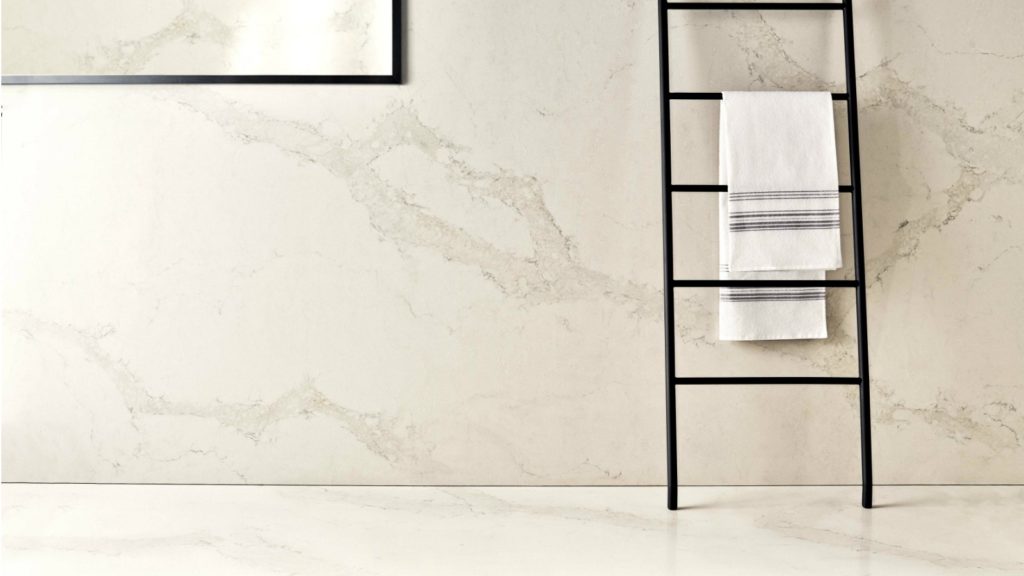
Quartz has been used to replicate natural stone with Caesarstone’s Calacatta Nuvo, shown here used on the wall. It is impervious to water, which makes it resistant to mould and mildew and is stain and scratch resistant
But there remains a sticking point, and that’s the gap between trade understanding of wall panelling and consumer awareness.
Although wall panelling is growing in popularity, with the likes of Bushboard’s Nuance range sales increasing 10-fold in as many years, according to its product sales manager Paul Findley, there is even greater opportunity for growth.
Educating consumers
Despite the growth in wall panelling sales, showroom manager at MP Moran & Sons Ed Pomgratoom points out: “Many people aren’t familiar with wet room panels and are surprised at the quality.
“Fibo’s range includes premium options with a routed grouted line that makes them indistinguishable from tiles – our customers just can’t tell the difference.”

The Linda Barker Collection from Multipanel uses True Scale laminate from Formica. The panels have been designed to look and feel like Calacatta marble or fossilised woods
It’s perhaps why Multipanel enlisted the support of interior designer and TV personality Linda Barker to launch a wall panelling collection, to help educate consumers.
Barker openly admits she was unaware of wall panelling before working on the project: “I didn’t know this existed and I’m spec’ing bathrooms. So if I didn’t know it was out there, everybody needs to be told about it.”
Installation advantages
Certainly, the use of wall panelling in a project is advantageous for both kitchen and bathroom retailers and consumers. Firstly, it removes the need for a specialist trade – the tiler – and so speeds up the installation process, which in turn saves costs on a project.
Managing director of Fibo UK Scott Beattie explains the benefits of fitting his company’s laminate panels: “There’s no need to make good the walls and no delay while the plaster dries because panels can be fitted directly to walls or onto stud partitioning. They are simply fixed to a wooden batten frame and finished with a sealant between the joints.”
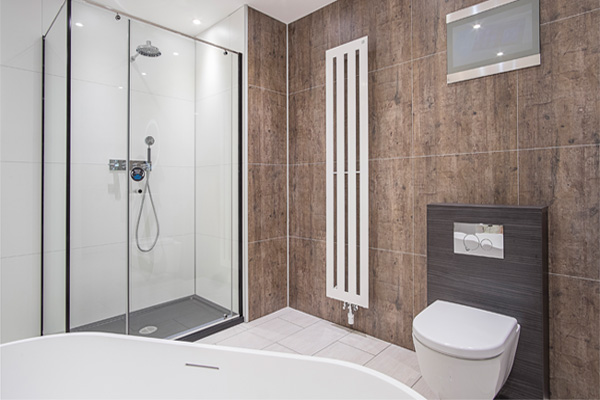
Laminate wall panels from Fibo can be combined in one scheme, such as Marcato tile effects in Roughwood and White. Grout lines are reduced to 1.8mm and the panels are guaranteed for 15 years
And to offer some statistics on how time installing wall panelling can save over fitting tiles, Paul Findlay of Bushboard adds: “In our installation time trials, Nuance panels are six times faster to install than ceramic tiling.
“When you add to that the cost of tiles, labour on site and the general mess of ceramic tiling, wall panelling is an exciting and profitable alternative.”
Ease of maintenance
But once installed, wall panelling is also easier to maintain for the homeowner – which is beneficial whether they are time pressured or part of the ‘grey consumer’ demographic perhaps future proofing their home.
Sales and Marketing Director for Ambiance Bain UK Nygel McCormac comments: “Busy lifestyles are influencing choice of products which are not only long-lasting but also easy to install and maintain.”
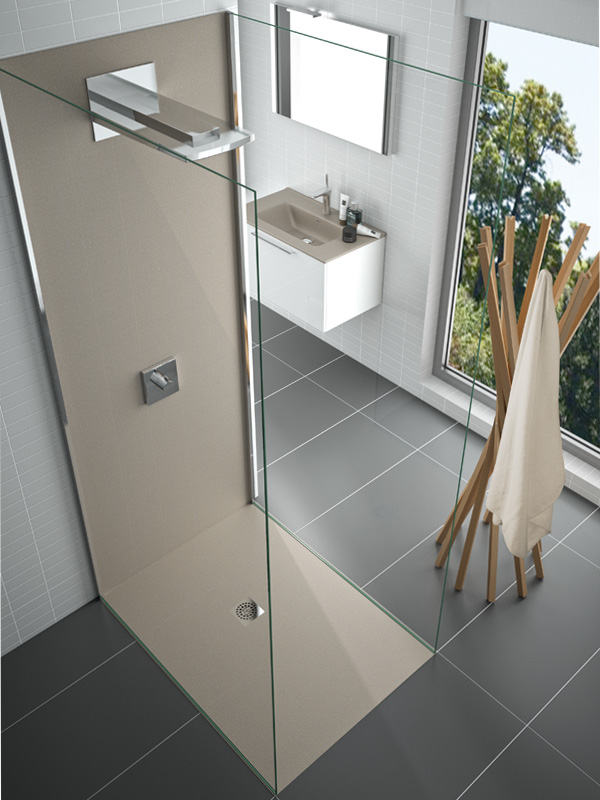
Made from natural stone powder with a gel coat, SMO from Ambiance Bain is used to create wall panels, shower trays and worktops with moulded basins. It comes in a choice of 200 colours, including Galaxy Sparkle
He adds: “Also the Disability Grant (DFG) provision to pay for improvements, such as accessible showering facilities, is set to double over the next two to three years to over £500million in 2019/20. All of these factors will include the growth of tiling alternatives which are easy to install, clean and maintain.”
Certainly, wall panelling can mean reduced grout lines, plus their waterproof nature means resistance to mould and mildew build-up. Laminate options can offer up to 15 years’ warranty, while the likes of more premium price cladding in quartz or ceramic provide scratch and stain resistant surfacing.
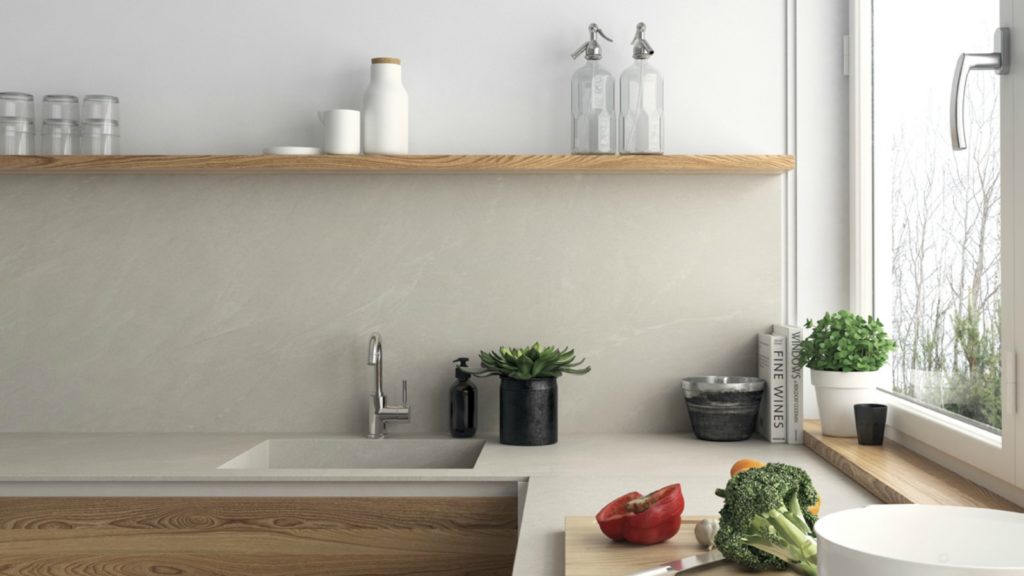
Co-ordinating the worktop and splashback in the kitchen is Ceralsio from CR Laurence, which is shown in Limestone with a textured finish. It comes in a 6mm thickness for wall cladding
Ease of cleaning and maintenance is particularly crucial in a kitchen, where cladding can come into play. Here, cladding can take the role of splashbacks, which can help in protecting the wall behind the hob and sink area from splashes, stains and watermarks.
VP of Caesarstone Jon Stanley adds: “Designers can continue the quartz up the wall, either as an upstand or as full kitchen splashback. Some of the most successful schemes involve using the same quality of quartz as a worktop for a run of units, as well as an island and kitchen table, with matching feature splashbacks to tie everything together.”
Meeting tile trend
And the timing for wall cladding has never been better, as there is an interior trend towards using large format tiles. Linda Barker explains: “We want less grout. We want ease of maintenance and large format tiles are so expensive. Wall panelling can offer the look and that’s the genius bit. Consumers understand large format tiles, so it’s not a great leap [for them] to think panels will look the same.”
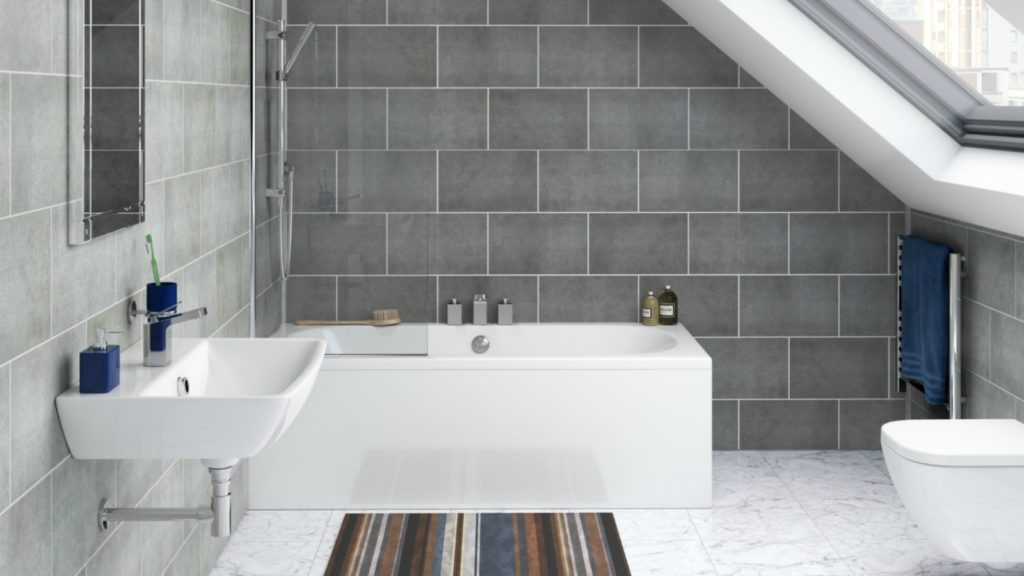
Part of the ‘tile’ range of Proplas PVC wall panelling from IDS is Stone Graphite, which features a realistic grout line. It comes with a five-year domestic use warranty and is available ex-stock
And this is reiterated in the use of ceramic cladding instead of tiles, as it was initially used to replicate marble. Managing director of CRL Europe Simon Boocock continues: “Ceramic cladding has all the advantages of ceramic tiles but it is thinner and larger than conventional tiling and can be used to cover large expanses, so is ideal for kitchen and bathroom walls.”
A natural choice
So what decors should designers consider to meet the trends of interior design-led clientele? Industry experts suggest look to replications of nature for inspiration, such as marble and woods.
Linda Barker adds: “I work a lot with natural and organic materials so stone is an absolute go-to and woods. The classic bathroom that will always stand the test of time is something like Calcatta or Carrera marble. There is still a trend for dark, interior spaces, particularly in places like spas.
“A lot of them aren’t clinical, white environments anymore; they are using richer and deeper colours which are much more seductive. So that is a trend bathrooms are going in.”
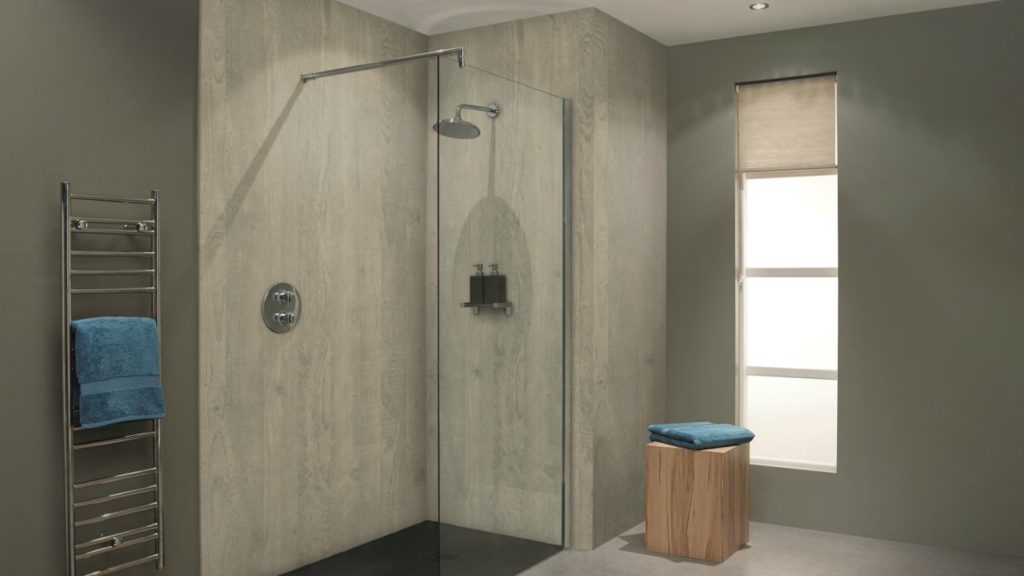
Chalkwood is a décor from Bushboard’s Nuance collection, which features post-formed edged panels and so doesn’t require trims or grout. Each panel measures 1200 x 2420mm and features tongue and groove jointing
It’s not just the patterning but the texture that is aiding the realism of wall cladding and pioneering its sales, as product manager of Showerwall Steph Harris explains: “There is so much more texture and depth in the decors that are available now, which can realistically replicated natural materials such as marble and stone.”
With the aid of digital printing, manufacturers are looking ever more closely at mirroring the look and feel of nature. Showerwall recently rebranded at KBB Birmingham, earlier this year, introducing its latest decors.
Steph Harris of Showerwall adds: “We have just introduced the first synchronised décor to the bathroom wall panelling market. In-line embossed printing, as it’s known, has transformed the fortunes of the flooring industry, enabling products to achieve exceptionally realistic looks, and we aim to transform bathroom panelling using the same technology.”
Bigger in bathrooms
While cladding definitely has its place in the kitchen, it is perhaps the bathroom where designers can maximise the use of wall panelling.
Nygel McCormac of Ambiance Bain explains: “Bathrooms are using wall cladding alternatives, predominately due to the upturn in substituting baths for showering solutions. Bathrooms also tend to have a larger area of tiling and therefore lend themselves much better to panelling solutions.”
But whether working on a bathroom project, or not, why not introduce tiling alternatives into the scheme? Designers shouldn’t be reticent because they think clients may have reservations; it may be simply because they are not aware of the advantages offered by the wide array of materials used for kitchen and bathroom cladding.



